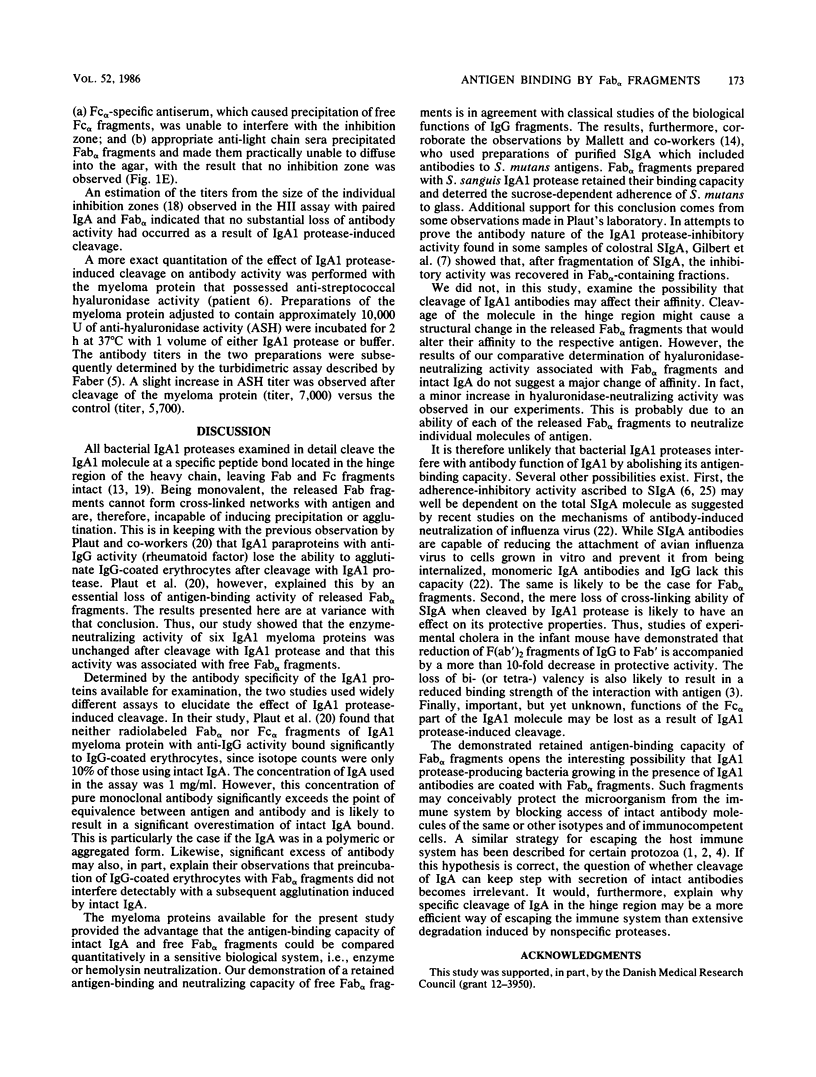Abstract
Immunoglobulin A1 (IgA1) proteases may be important virulence factors of certain bacteria involved in the pathogenesis of meningitis, gonorrhea, destructive periodontal diseases, and some other infections affecting mucosal membranes. This study evaluated the antigen-binding activity of free Fab alpha fragments released from human myeloma IgA1 by IgA1 protease from Haemophilus influenzae. Six myeloma proteins with antibody activity against streptolysin O, alpha-staphylolysin, or streptococcal hyaluronidase were used. Complete cleavage of the IgA1 myeloma proteins in the hinge region of the heavy chain did not affect their antigen-binding capacity. The titers of neutralizing activity associated with free Fab alpha fragments were not significantly different from those of the intact IgA1 proteins. The retained antigen-binding capacity of cleaved IgA1 is an important factor in the understanding of how IgA1 proteases may interfere with the immune protection of mucosal membranes.
Full text
PDF



Images in this article
Selected References
These references are in PubMed. This may not be the complete list of references from this article.
- Auriault C., Ouaissi M. A., Torpier G., Eisen H., Capron A. Proteolytic cleavage of IgG bound to the Fc receptor of Schistosoma mansoni schistosomula. Parasite Immunol. 1981 Spring;3(1):33–44. doi: 10.1111/j.1365-3024.1981.tb00383.x. [DOI] [PubMed] [Google Scholar]
- Chapman C. B., Mitchell G. F. Proteolytic cleavage of immunoglobulin by enzymes released by Fasciola hepatica. Vet Parasitol. 1982 Nov;11(2-3):165–178. doi: 10.1016/0304-4017(82)90039-5. [DOI] [PubMed] [Google Scholar]
- Crothers D. M., Metzger H. The influence of polyvalency on the binding properties of antibodies. Immunochemistry. 1972 Mar;9(3):341–357. doi: 10.1016/0019-2791(72)90097-3. [DOI] [PubMed] [Google Scholar]
- Eisen H., Tallan I. Tetrahymena pyriformis recovers from antibody immobilisation by producing univalent antibody fragments. Nature. 1977 Dec 8;270(5637):514–515. doi: 10.1038/270514a0. [DOI] [PubMed] [Google Scholar]
- FABER V. Anti-streptococcal-hyaluronidase. II. Turbidimetric determination of anti-streptococcal-hyaluronidase in the sera of normal individuals. Acta Med Scand. 1953;145(6):458–464. [PubMed] [Google Scholar]
- Gilbert J. V., Plaut A. G., Longmaid B., Lamm M. E. Inhibition of microbial IgA proteases by human secretory IgA and serum. Mol Immunol. 1983 Sep;20(9):1039–1049. doi: 10.1016/0161-5890(83)90045-7. [DOI] [PubMed] [Google Scholar]
- Johansson B. G. Agarose gel electrophoresis. Scand J Clin Lab Invest Suppl. 1972;124:7–19. doi: 10.3109/00365517209102747. [DOI] [PubMed] [Google Scholar]
- Kilian M., Mestecky J., Schrohenloher R. E. Pathogenic species of the genus Haemophilus and Streptococcus pneumoniae produce immunoglobulin A1 protease. Infect Immun. 1979 Oct;26(1):143–149. doi: 10.1128/iai.26.1.143-149.1979. [DOI] [PMC free article] [PubMed] [Google Scholar]
- Kilian M., Thomsen B., Petersen T. E., Bleeg H. S. Occurrence and nature of bacterial IgA proteases. Ann N Y Acad Sci. 1983 Jun 30;409:612–624. doi: 10.1111/j.1749-6632.1983.tb26903.x. [DOI] [PubMed] [Google Scholar]
- Mallett C. P., Boylan R. J., Everhart D. L. Competent antigen-binding fragments (Fab) from secretory immunoglobulin A using Streptococcus sanguis immunoglobulin A protease. Caries Res. 1984;18(3):201–208. doi: 10.1159/000260766. [DOI] [PubMed] [Google Scholar]
- Mansa B., Kjems E. Extremely high content of anti-alpha-staphylolysin in serum samples from a patient with multiple myeloma. Acta Pathol Microbiol Scand. 1965;65(2):303–310. doi: 10.1111/apm.1965.65.2.303. [DOI] [PubMed] [Google Scholar]
- Mansa B., Kjems E., Lind I. Localization of the antibody combining sites of M-component with known antibody specificity. Prog Immunobiol Stand. 1970;4:60–65. [PubMed] [Google Scholar]
- Plaut A. G., Gilbert J. V., Wistar R., Jr Loss of antibody activity in human immunoglobulin A exposed extracellular immunoglobulin A proteases of Neisseria gonorrhoeae and Streptococcus sanguis. Infect Immun. 1977 Jul;17(1):130–135. doi: 10.1128/iai.17.1.130-135.1977. [DOI] [PMC free article] [PubMed] [Google Scholar]
- Plaut A. G. The IgA1 proteases of pathogenic bacteria. Annu Rev Microbiol. 1983;37:603–622. doi: 10.1146/annurev.mi.37.100183.003131. [DOI] [PubMed] [Google Scholar]
- Steele E. J., Chaicumpa W., Rowley D. Further evidence for cross-linking as a protective factor in experimental cholera: properties of antibody fragments. J Infect Dis. 1975 Aug;132(2):175–180. doi: 10.1093/infdis/132.2.175. [DOI] [PubMed] [Google Scholar]
- Taylor H. P., Dimmock N. J. Mechanism of neutralization of influenza virus by secretory IgA is different from that of monomeric IgA or IgG. J Exp Med. 1985 Jan 1;161(1):198–209. doi: 10.1084/jem.161.1.198. [DOI] [PMC free article] [PubMed] [Google Scholar]
- Videbaek A., Mansa B., Kjems E. A human IgA-myeloma protein with anti-streptococcal hyaluronidase (ASH) activity. Scand J Haematol. 1973;10(3):181–185. doi: 10.1111/j.1600-0609.1973.tb00057.x. [DOI] [PubMed] [Google Scholar]
- Weeke B. A manual of quantitative immunoelectrophoresis. Methods and applications. 1. General remarks on principles, equipment, reagents and procedures. Scand J Immunol Suppl. 1973;1:15–35. doi: 10.1111/j.1365-3083.1973.tb03776.x. [DOI] [PubMed] [Google Scholar]
- Williams R. C., Gibbons R. J. Inhibition of bacterial adherence by secretory immunoglobulin A: a mechanism of antigen disposal. Science. 1972 Aug 25;177(4050):697–699. doi: 10.1126/science.177.4050.697. [DOI] [PubMed] [Google Scholar]



